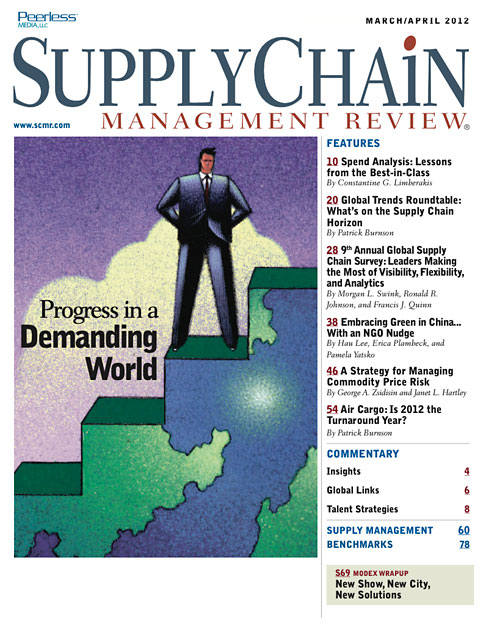Sorry, but your login has failed. Please recheck your login information and resubmit. If your subscription has expired, renew here.
March-April 2012
New research from the Aberdeen Group under-scores the importance of spend analysis. The findings, however, also show a gap between those companies struggling to implement a spend analysis program and the best in class. Aberdeen’s Constantine Limberakis relates the lessons learned from these leaders that can move you up the competency ladder. Browse this issue archive.Need Help? Contact customer service 847-559-7581 More options
Apple. Motorola. Pepsi. HP. Timberland. Walmart. These are among the thousands of global corporations that a small Beijing-based nonprofit organization has exposed as sourcing from polluting factories in China over the last six years. The nonprofit — the Institute of Public & Environmental Affairs (IPE) — has surprising clout. To date, more than 200 corporate giants have explained to IPE offcials why their manufacturing facilities or suppliers in China were in violation of the country’s air and water laws. To get off IPE’s “blacklist,” at least 50 companies have taken corrective actions and agreed to IPE-supervised environmental audits of their factories. A growing number of those companies are now using IPE’s Web site as a tool to screen and monitor their Chinese suppliers’ environmental performance.
That’s not bad for a homegrown seven-man operation working out of a modest office in a converted sixth-floor Beijing apartment. By taking advantage of greater environmental transparency in China and global corporations’ desire to protect their reputations, IPE has become one of the country’s leading environmental watchdogs, powerful enough to spur some multinationals to pay more attention to their Chinese suppliers’ environmental records and to lean on offending suppliers to fix problems.
Not surprisingly, some companies see the little NGO (non-governmental organization) as a nuisance, ignoring its notifications of suppliers’ environmental infractions for as long as possible. Apple, for instance, paid no heed to IPE’s entreaties for months until embarrassing headlines, such as “Apple Attacked over Pollution in China,” in August 2011, scandalized newswires. But far-sighted companies such as Walmart and Nike are embracing IPE as a partner in improving their environmental management of their Chinese supply chains. “The IPE Web site provides a really good platform for us to reduce the risk of environmental violations,” says May Qiu, Nike’s health, safety, and environment manager for Asia.
 |
This complete article is available to subscribers
only. Click on Log In Now at the top of this article for full access. Or, Start your PLUS+ subscription for instant access. |
Not ready to subscribe, but need this article?
Buy the complete article now. Only $20.00. Instant PDF Download.
Access the complete issue of Supply Chain Management Review magazine featuring
this article including every word, chart and table exactly as it appeared in the magazine.
SC
MR
Sorry, but your login has failed. Please recheck your login information and resubmit. If your subscription has expired, renew here.
March-April 2012
New research from the Aberdeen Group under-scores the importance of spend analysis. The findings, however, also show a gap between those companies struggling to implement a spend analysis program and the best in… Browse this issue archive. Download a PDF file of the March-April 2012 issue.
 |
Download Article PDF |
Apple. Motorola. Pepsi. HP. Timberland. Walmart. These are among the thousands of global corporations that a small Beijing-based nonprofit organization has exposed as sourcing from polluting factories in China over the last six years. The nonprofit — the Institute of Public & Environmental Affairs (IPE) — has surprising clout. To date, more than 200 corporate giants have explained to IPE offcials why their manufacturing facilities or suppliers in China were in violation of the country’s air and water laws. To get off IPE’s “blacklist,” at least 50 companies have taken corrective actions and agreed to IPE-supervised environmental audits of their factories. A growing number of those companies are now using IPE’s Web site as a tool to screen and monitor their Chinese suppliers’ environmental performance.
That’s not bad for a homegrown seven-man operation working out of a modest office in a converted sixth-floor Beijing apartment. By taking advantage of greater environmental transparency in China and global corporations’ desire to protect their reputations, IPE has become one of the country’s leading environmental watchdogs, powerful enough to spur some multinationals to pay more attention to their Chinese suppliers’ environmental records and to lean on offending suppliers to fix problems.
Not surprisingly, some companies see the little NGO (non-governmental organization) as a nuisance, ignoring its notifications of suppliers’ environmental infractions for as long as possible. Apple, for instance, paid no heed to IPE’s entreaties for months until embarrassing headlines, such as “Apple Attacked over Pollution in China,” in August 2011, scandalized newswires. But far-sighted companies such as Walmart and Nike are embracing IPE as a partner in improving their environmental management of their Chinese supply chains. “The IPE Web site provides a really good platform for us to reduce the risk of environmental violations,” says May Qiu, Nike’s health, safety, and environment manager for Asia.
 |
SUBSCRIBERS: Click here to download PDF of the full article. |
SC
MR

Latest Supply Chain News
Latest Podcast

 Explore
Explore
Latest Supply Chain News
- Strengthening customer fulfillment: Building a strategic stakeholder network
- The hard job of teaching soft skills
- Trump picks former Wisconsin congressman Sean Duffy for DOT secretary
- Made in Mexico, manufactured by China
- Retail sales see gains in October, reports Commerce and NRF
- Balancing green and speed: Home delivery insights from the pandemic era
- More latest news
Latest Resources

Subscribe

Supply Chain Management Review delivers the best industry content.

Editors’ Picks





